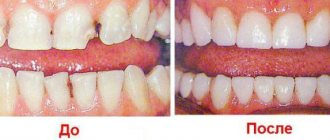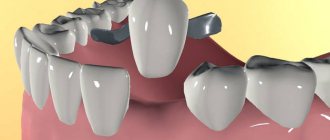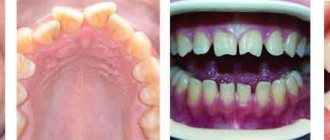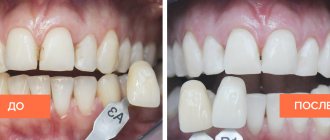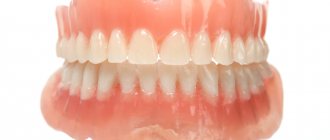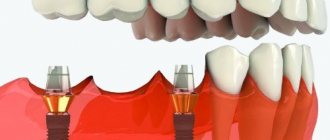Publication date: 06/21/2020
There are a number of reasons (trauma, caries, short crown) why only the root and a small part of the crown remain from the tooth, and the rest of the dental tissue is lost. Until recently, in this case, fillings, a prosthesis were installed, or a tooth was removed. Currently, it is possible to use restoration options that allow you to recreate the original appearance of the tooth. The restored tooth looks natural and aesthetically pleasing. An important condition is that the root must be intact. Computer technology is used to create a copy of the crown of a future tooth.
Indications and contraindications for tooth augmentation
Teeth augmentation is a multi-stage technology for restoring the aesthetic appearance and functions of the jaw, which was susceptible to chipping or erased as a result of increased tone of the masticatory muscles, called buxism.
Indications for the tooth augmentation procedure:
- chips resulting from injuries;
- numerous caries lesions;
- large distance between teeth;
- wedge-shaped defect;
- the presence of a gap between the two front teeth;
- congenital structural pathologies;
- thinning and demineralization of enamel due to consumption of junk food and lack of oral hygiene;
- cervical caries;
- the presence of errors in previous dental sessions that resulted in the destruction of healthy tissue;
- malocclusion.
Having asked the dentist a question about what tooth extension is called, the patient will immediately hear the answer. The procedure is called dentition restoration. Modern extension technologies make it possible to restore the structure in most cases without resorting to its removal. The procedure is harmless, but has a number of contraindications:
- patient age – more than 60 years;
- children's age when using pins;
- presence of a cyst;
- inflammation of the gums;
- pregnancy in the first or third trimester;
- failure to comply with personal hygiene rules;
- periodontitis and stomatitis;
- jaw fracture and other injuries.
If a patient is diagnosed with diseases that are contraindications, the dentist first treats them, and then restores the dentition.
Correction with crowns
The installation of crowns as tooth extensions is also used in cases where the tooth is not destroyed, but is sufficiently damaged. Installing a crown is one of the effective ways to restore a broken tooth, this applies to both front and chewing teeth. Crowns are also used in cases where it is not possible to fill a chewing tooth, for example, because the cavity left after caries treatment is too large. This type of permanent prosthetics, such as crowns, is an ideal solution in cases where more than 70% of the crown part of the tooth is missing.
In modern aesthetic dentistry, ceramic and metal-ceramic crowns are successfully used. The installation process itself takes place in two stages. First, the doctor prepares the tooth (removes infected tissue, grinds down the walls), then an impression is taken, from which a crown for a chewing tooth or a crown for a front tooth is made in a dental laboratory. The second stage is the fitting and installation of the finished crown. Modern ceramics, used for the manufacture of inlays and crowns, make it possible to perfectly imitate the texture, color and transparency of natural enamel, as well as select a shade in accordance with the color of neighboring teeth.
Teeth extension methods
There are 2 main extension methods:
- Straight. Used if tooth decay is up to 30%. During the procedure, composite or photopolymer materials are used to build teeth. The former are less durable and harden after 30 minutes. The latter have a service life of 10 years and remain plastic until exposed to the lamp.
- Indirect. Applicable when damage affects no more than 70% of the structure. The method has several stages, including taking impressions, making and installing ceramic inlays.
If you have ever thought about whether a crown or extension is better, then you should know that a crown is installed when more than 70% of the tissue is destroyed, but a intact and healthy root remains.
What is a pin
In modern dentistry, various designs are used to recreate damaged teeth.
A pin is one such structure that serves as a support for filling material or a crown. The pin is installed in the root cavity after the nerve is removed. Thanks to this procedure, it is possible to preserve the root, dentition and original structure of the jaw.
The main task of the pin, which is installed on a pulpless tooth, is to evenly distribute chewing pressure. Thus, when chewing, parts of the restored tooth will not experience increased pressure and will not be damaged.
Features of front teeth extensions
Restoration of anterior teeth is carried out in the following cases:
- Yellowing of enamel;
- Damage to caries;
- Minor curvature;
- Presence of chips or chips;
- Grayish-yellow coating.
Composites and photopolymers are used for extensions, but veneers are the most popular. They are used for minor damage to healthy tissue. If the tooth body is deeply damaged, it is removed from the roots and an implant is implanted in its place. Types of veneers presented in our clinic: composite veneers, ceramic veneers.
Chips of baby teeth often occur in childhood. Many parents do not pay attention to this, hoping for the speedy growth of indigenous children. This is wrong, as the sharp edges scratch the tongue, causing inflammation and infection. Children's extensions are made using composite materials and are absolutely painless.
How a tooth is restored: stages of treatment
The extension procedure on a pin takes place in several stages:
- Diagnostics . Before starting the procedure, a thorough study is carried out. The patient undergoes a three-dimensional computed tomography and orthopantomogram of the jaw. It is important to consider in detail how damaged the tooth is in order to select the necessary pin and method of restoration.
- Taking impressions . To carry out restoration work, impressions are first taken. This procedure is performed if the patient has a crown installed. It is important that the crown fits anatomically into the dentition without causing discomfort to the patient.
- Bone grafting . Some patients undergo bone grafting before the augmentation procedure. This is necessary for bone deficiency.
- Installation of the pin . A pin is installed in the root. It is fixed with cement or screwed in (if the pin is active, threaded).
- Filling . The free space in the pin area is filled with composite material.
- Restoration . The final part of the procedure is when the tooth is restored. The doctor uses a durable filling material to recreate the coronal part. The restoration is carried out using a high-strength photopolymer that will last the patient up to 10 years. Now the restored part has a double support - the root and an installed pin that can withstand the loads on the tooth.
If the patient decides to undergo prosthetics, a crown is installed on the pin. Initially, a temporary crown is placed on the post. The patient stays with it until the dental technician makes a metal-ceramic crown based on the impression. The patient is then fitted with a permanent crown, secured with cement. In the future, work on polishing and correction of the permanent crown is possible.
Tooth extension onto a pin
When thinking about whether it is possible to build a tooth onto the root, the use of a pin comes to mind. It is used if both the body and the root are severely damaged.
The procedure includes:
- obtaining an x-ray;
- cleaning the mouth, removing stones;
- removal of damaged areas;
- computer tooth modeling;
- removal of saliva;
- anesthesia;
- cleaning of channels;
- implantation of a pin, cleansing the area around it;
- filling the space around the pin with a composite or photopolymer;
- polishing and grinding.
Dentists build up teeth under crowns only if the remainder is in good condition and does not rot or decompose.
Which restoration method to choose?
There is no clear answer here for obvious reasons. It all depends on the degree of damage that the crown and root have. If we talk about the direct method, it is as gentle as possible, since its implementation does not require first removing the nerves. The composite material is applied to the crown in layers. At the same time, the tooth is still “alive” and is able to perform its original functions.
It is not possible to use the indirect method without first removing the nerves. An orthopedist implants inlays and pins into the root canals of a tooth with a dead nerve, after which a layer-by-layer application of composite material is performed. If the patient has significant damage to the crown, this extension option is the only possible one.
Does it hurt to grow teeth?
Tooth extension is a painless procedure. Anesthesia is not performed if the damage is not significant, since manipulations are carried out at a superficial level. If the damage is severe, the dentist administers local anesthesia. Modern drugs begin to act immediately after administration.
After the session, the first day you may experience pain if the canals were cleaned. Painkillers will help you feel better.
The restored dentition will last a long time if the patient provides proper care. If the question arises about whether it is possible to smoke after tooth extensions, the answer will be negative. Composite and photopolymer materials quickly absorb all substances, which is why the filling quickly changes color. Maintaining hygiene and regular visits to the dentist will help you maintain your smile for a long time.
Reliability and service life
The service life of the extended tooth elements varies quite significantly. Average range: 5 to 20 years. This difference is explained by several factors:
- selected material and extension method,
- individual characteristics of the patient,
- quality of workmanship,
- care of handling.
Systematic preventive visits to the dentist, as well as additional polishing of the tooth surface using specialized drill discs, will help to avoid shrinkage and fading of the composite over time.
Special cases
Some injuries require a specific approach, which has its own characteristics against the backdrop of generally established rules. We should look at them in more detail.
Wisdom tooth
"Eights" cannot be restored. The fact is that this makes no sense, because they are not involved in the process of chewing food and are not so important for the functioning of the maxillofacial apparatus. Doctors resort to extraction; subsequent prosthetics are not performed.
Unit
Such damage is the most aesthetically unattractive, because it is visible to others if a person smiles or simply talks. Treatment methods can be any, it all depends on the dentist’s recommendations and the patient’s personal preferences and financial capabilities.
Most often, artistic restoration is used. The specialist selects the composition of the required shade and applies it to the surface. The layer of material is fixed with a special device with light radiation.
What to do if half a tooth breaks off, how will it be treated (a significant fragment has broken off along with dentin)? In this case, veneers are used. This is a reliable method that is durable. Over time, the color of the enamel does not change and remains attractive.
For the most serious damage, crowns made of ceramics, metal-ceramics, and zirconium oxide are installed. The final cost of therapy depends on the choice.
Lateral teeth
They are treated in the same way as the front ones. However, since others cannot see from the outside that there is anything wrong with your smile, ordinary fillings will do. The best option is extension. Overlays are not installed in this case.
If the nerve is damaged, the wound is first treated with an antiseptic. Then depulpation or extraction is carried out followed by prosthetics.
Dairy elements
What to do with a chipped tooth and how to treat it if it hurts? Many parents mistakenly believe that there is no need to correct problems that arise with children’s first incisors, canines and molars - they will fall out sooner or later anyway. This is a big misconception, because the doctor is able to quickly stop further cracking with a filling or a special gel without pain or other unpleasant sensations.
Children are often injured due to falls during active play. If you ignore the treatment of chips, this often leads to stomatitis and increased sensitivity of the dentition.
Procedure:
- calm the baby;
- give him clean water to rinse his mouth;
- disinfect soft tissues if they are damaged;
- save the fragment for the dentist.
No more than 24 hours should pass from the moment of injury to the visit to the dentist. Most likely, the child will be sent for an X-ray. The condition of the permanent one depends on the health of the primary occlusion.
Vertical crack
What should you do if your front tooth chips a little, but the absence of fragments is not visible, only a crack running from top to bottom is noticeable? At first glance, this problem seems insignificant. However, this opinion is erroneous, because most often the pulp is involved. In this case, the enamel layer cannot be restored.
If at first only a small strip is visible on the surface, over time, under constant pressure, it develops into large chips. Timely consultation with a doctor guarantees quick and easy restoration of the dental unit. Otherwise, you cannot do without installing crowns or veneers.
When can a tooth be restored?
When the walls have completely crumbled, but the root of the tooth has not been destroyed, traditional dentistry sometimes suggests removing it. Today, using new protocols, it is possible to preserve the root and create a new stable unit - any of the functional ones, except for the “eights” (wisdom teeth). To do this, you need the root to be healthy:
- Not affected by caries, without fractures or cracks. If such defects exist, then only removal followed by implantation is indicated.
- No cyst. If there is one, then a method of treatment is selected. And only then can you begin to restore.
If a similar problem happens to you, do not rush to the surgeon. New technologies make it possible to accomplish the previously impossible - to preserve the root of a tooth. What to do in a particular case is decided at the appointment, after diagnosis. The vast majority of patients manage to save the tooth after treatment procedures and install a crown on the root of the tooth.
To grow a tooth or strengthen the enamel?
All advice on how to grow teeth at home only concerns strengthening tooth enamel. It is really possible to build up, or rather strengthen, tooth enamel at home. With age it becomes thinner; various metabolic disorders in the body, lack of calcium and fluoride make it loose, which is why the tooth is easily attacked by bacteria. To avoid problems, you need to take vitamin complexes, review your diet, and use special toothpastes and mouthwashes.
Under no circumstances should you prescribe all this to yourself. Be sure to consult your dentist! The clinic will offer you a remineralization procedure, the purpose of which is to strengthen the enamel. This will help keep your teeth healthy, but you won’t be able to build them up this way.
Enamel implantation with Innodent
The procedure is new, but has already proven itself as an effective method for restoring tooth enamel .
- Painlessly cures caries in 1 month
- Relieves tooth sensitivity
- Removes white spots after braces
- Strengthens and mineralizes enamel
Description of the procedure:
Innodent is applied to the tooth surface, which in turn is integrated into the enamel structure at the molecular level. This is achieved through active substances whose characteristics coincide with dental tissues.
Main results:
Cracks and damage to the enamel are completely eliminated, the integrity of the tooth enamel is restored and the process of regeneration of the natural structure begins.
When will the results of the procedure be visible?
You will see the first results 3 days after the start of the procedure, but the process of tooth enamel regeneration itself can last 1-1.5 months. A decrease in the sensitivity of enamel to mechanical and temperature stimuli also occurs gradually. In individual cases, it is possible to re-use the drug after 3-4 months.
Indications for the dental enamel implantation procedure
Below we will describe the main indications for which enamel implantation will be the most effective restoration method.
- High sensitivity of teeth (temperature and mechanical)
- Damage (chips) and cracks in tooth enamel
- Wedge-shaped defect (hyperplasia)
- Tendency of teeth to the spread of caries
- Pigment spots on the surface of tooth enamel
- At the initial stage of caries spread
An important feature of the drug is the possibility of use for preventive purposes, as well as in conjunction with teeth whitening procedures. Effectively copes with the treatment of enamel demineralization. It is possible to carry out the procedure after correction with braces in order to eliminate age spots on the surface of the enamel.
Are there any contraindications to the procedure?
The procedure is completely safe and has no contraindications as such. However, in rare cases, the following are possible: an allergic reaction and individual intolerance to one or more components of Innodent. You should not carry out the procedure with major damage to the internal tissues of the tooth.
Pros and cons of dental enamel implantation with Innodent
Main advantages:
- High degree of safety and natural ingredients
- Suitable for pregnant women and children (including baby teeth)
- As a result, you get smooth enamel with a natural shade
- Stains and damage are completely eliminated within a month
- Can be used at the initial stage of caries development and thereby avoid drilling and filling teeth
- Complete painlessness and absence of discomfort for the patient at all stages of the procedure
- The procedure is quick - about 15-25 minutes for everything
- The result lasts really long (from 1 to 3 years)
Flaws:
- Price - the method is not the cheapest, but in terms of price-quality ratio it has no analogues
- Really good results are possible a month after the procedure
- Does not solve the problem with large defects (internal tooth decay)
Dental implantation with the help of Innodent has allowed modern dentistry to truly restore enamel, and not replace it with temporary solutions.
A completely new approach to enamel restoration
